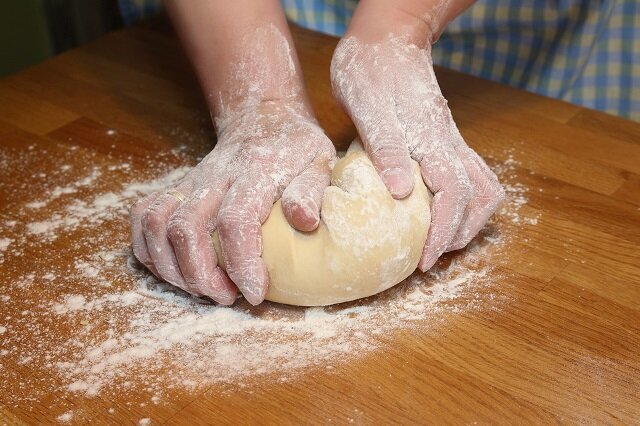
Kneading
To knead or kneading is a process in the making of bread, scones or pasta dough, and is used to mix the ingredients and add strength to the final product.
Its importance lies in the mixing of flour with water.
When these two ingredients are combined and kneaded, the gliadin and glutenin proteins in the flour expand and form strands of gluten, which gives bread its texture.
To aid gluten production, many recipes use bread flour, which is higher in protein than plain flour.
The kneading process warms and stretches these gluten strands, eventually creating a springy and elastic dough.
Kneading Tips
- Kneading can be performed by hand (the traditional way), with a mixer equipped with a dough hook, or with a bread machine.
The process is to work the dough by folding, pushing away, turning slightly then repeating. - Bread dough is kneaded for at least 10 minutes to develop the gluten in the dough.
If bread dough is not kneaded enough, it will not be able to hold the tiny pockets of gas (CO2) created by the leavening agent, such as yeast or baking powder), and will collapse, leaving a heavy and dense loaf. - Scone or pastry dough is kneaded lightly and gently and only once or twice to make dough smooth.
- Over-kneading will result in tough scones or pastry dough!
How to knead dough
- Wash your hands before kneading.
Kneading requires working the dough between your bare hands, so wash them and dry them well before you begin.Remove your jewelry that might get caught in the dough, and roll up your sleeves so they don’t get sticky.
- Gather the dough into a pile. When you first plunge your hands into the dough, it will be sticky and difficult to gather.
- Prepare a flat surface for kneading. It’s easiest to knead dough on a flat surface that comes up to the level of your waist. Prepare a countertop, table, or another stable surface for kneading by cleaning it with warm, soapy water, then wiping it completely dry with a towel.
Sprinkle flour over the dry surface so the dough won’t stick when it’s time to knead. - Combine the ingredients for your dough. Use the ingredient amount listed in the recipe you are using. Basic dough ingredients are usually flour, yeast, salt, and water. Mix the ingredients well with a wooden spoon in preparation for kneading.
- If loose flour is still sticking to the sides of your mixing bowl, the dough is not yet ready to knead.
Keep stirring it with a spoon until all the ingredients are combined. - If you’re having trouble moving the wooden spoon through the dough, it’s ready to be kneaded.
- If loose flour is still sticking to the sides of your mixing bowl, the dough is not yet ready to knead.
- Turn the dough onto your work surface. Dump it from the bowl directly onto the flat surface you prepared.
It should form a loose, sticky ball. The dough is now ready to be kneaded.
- Go ahead and work the dough with your hands, forming it into a ball, pressing it down and reshaping it.
Continue doing so until the dough is no longer as sticky, and it becomes possible to shape it into a ball without the dough falling apart.
- If the dough doesn’t seem to be losing its stickiness, sprinkle more flour over the top and work it into the dough.
- You can lightly dust your hands with flour to keep the dough from sticking too much.
- Punch the dough. Press the heels of your hands into the dough, pushing forward slightly.
This is called “punching” the dough and helps the gluten start working.Continue doing this until the dough is slightly springy.
- Continue to work the dough. To knead the dough, fold the dough in half and rock forward on the heels of your hands to press it flat.
Turn the dough slightly, fold it in half, and rock into it again with the heels of your hands. Repeat for 10 minutes, or as long as the recipe tells you the dough should be kneaded.
- The kneading process should be rhythmic and steady.
Don’t work too slowly; handle each part of the dough quickly, never letting it rest for too long between turns.
- Look for a tacky texture. The dough starts out sticky and lumpy, but after 10 minutes of kneading it should be shiny and smooth.
It should be tacky to the touch with an elastic feel.
If any lumps or sticky parts remain, continue kneading the dough.
How to knead dough by hand
SAVEUR food editor Ben Mims shows you a foolproof trick for kneading dough by hand so that your bread comes out perfectly every time.
How to knead dough using a dough hook
Making your own dough has never been easier!
Anneka Manning shows us how easy it is to do using your Stand Mixer’s dough hook.